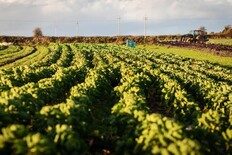Wireworms remain a formidable pest of crop production and a big problem in potatoes.
As well as any yield reduction, they can seriously affect saleable yield, as the presence of long narrow tunnels in tubers are not endearing to consumers.
A presentation at the World Potato Congress recently by Martyn Cox from Blackthorn Arable Ltd in the UK explained that the problem has gotten worse in the UK and other countries in recent years.
He acknowledged that there is still little that can be done to control a population once it has become established in a field and so the ability to test bait or assess population levels is critical to help avoid big problems.
Martyn reported that he had reviewed research carried out all over the world to assess if it included new ways to detect larvae and improve risk assessment.

This recent research has helped improve our chances of finding larvae in advance of problems appearing and our understanding of the limitations of adult monitoring using pheromone traps.
Monitoring ability has improved
Martyn rejects the commonly held belief that wireworm damage only happens later in the season and he explained how monitoring in growing crops has been improved.
He explained that epidemic-scale problems drove a lot of research activity between the two World Wars when significant problems occurred when grass was ploughed up for crop production.
The problem largely went away following the frequent use of persistent organochlorine insecticides and then the research largely ceased too.
However, the loss of these insecticides and the use of farming systems which are more suitable for the pest seems to have led to an increase in problems in recent years and research is once again taking note.
Life cycle and control
While we normally regard the full life cycle as four years, Martyn commented that it is actually five years, which is four years in the instar larval phase plus one year as an adult laying eggs.
A number of different species cause problems, but they have certain things in common.
They lay their eggs in the May/June period and these can hatch out relatively quickly, depending on conditions.
In terms of our ability to control the pest, Martyn reinforced the fact that there is no magic bullet, no one single thing that will do the job.
However, he reinforced the fact that the single best place in their life cycle to go after them is the second half of the year in which they hatch.
At this point, the larvae are small and they need to feed actively to fuel their growth. Once larvae get big, it is very difficult to do things that will actively reduce numbers.
Environmental actions drive problems
Martyn noted that many of the things that growers are being asked to do for the benefit of the environment are also positive for wireworms, especially for their survival in the early months of their life cycle.
Put simply, environmental measures that encourage plant growth in what might normally be plant-free periods will nearly always make a problem bigger by helping more larvae to survive in year one.
The best place to target number reduction is after a cereal crop in a rotation
Green covers may actually increase wireworm populations.
For this reason, he said that the best place to target number reduction is after a cereal crop in a rotation.
Having stubbles bare at this point is likely to reduce the number of young larvae that survive because they have very little food.
This means that the new cultivation measure being imposed under nitrates actions is likely to exacerbate this problem, especially for potato producers.
Still learning
Martyn said that we are still learning and he suggested that we may find a crop species which wireworms will not feed on.
Such an option would help protect the environment, but not add to the risk of higher wireworm numbers.
He also stated that stubble cultivation or establishment system have no impact on wireworm survival.
Asked about the impact of global warming, he commented that the main impact of higher temperatures is that it shortens the length of the life cycle, possible from four to two-and-a-half years. This obviously increases the potential risk over time.
Baiting
The use of baits and traps for larvae and adult beetles can help focus risk. Pheromone traps can be used for flying beetles, but he emphasised that beetle number is not correlated to numbers of larvae.
This is partly because the larvae present could be from any one of the four previous years' life cycles.
Larvae baits can be quite useful to indicate risk. However, they only work when soil temperature exceeds 8C. Below that, the larvae will just not migrate to the bait site.
The bait itself is a mix of a bunch of wheat and maize seedlings. Sow the seeds in an area the size of your hand and then monitor it over time.
Martyn commented that baiting does help improve the overall assessment of risk, as it helps identify population levels.
Control
There is no real control without chemicals, but the best place to target action is a plant-free scenario after a cereal crop.
Not having food present will significantly reduce juvenile numbers in particular, more so that older larvae.
Cereals and grasses are their preferred food and survival of juveniles is likely to be helped where these are present on land in the backend.






 This is a subscriber-only article
This is a subscriber-only article










SHARING OPTIONS: